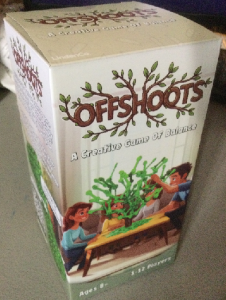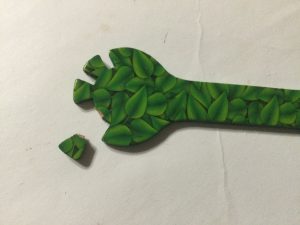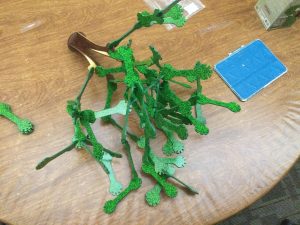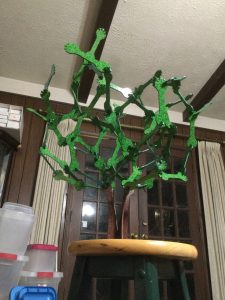| Publisher | Offshoots, LindenCo |
| Design Credits | Dan Linden |
| Game Contents | Two-part wooden tree, base, 75 “leaves,” construction instruction card |
| Guidelines | Botany-based upside-down stacking game |
| MSRP | $29.99, $34.99 (Made in America version) |
| Reviewer | Andy Vetromile |
If you’re like most gamers you look at Jenga and think to yourself, “Eh, it’s nice, but why doesn’t it hang suspended in the air?” This pervasive issue has been solved with the invention of Offshoots, a version of tower building that takes to the skies . . . or at least the treetops.
The object is to place the last successful leaf before the tree falls over.
One to a billion people (the box recommends 12 if you haven’t seating for that many) sit around a tree trunk and start inserting leaves into it one at a time in turn order. They can be placed in the bole itself or into a previously installed leaf. Notches at either end of the playing pieces allow them to hang at various angles, producing a bushy sort of arrangement that becomes less stable the more wood you have dangling off the tree.
Able arborists all, the players branch out into the larger structure until someone makes a misstep. If putting up limbs destabilizes something enough, or bumping the “playing field” causes trouble, any leaves that fall off the tree must be replaced into the network somewhere new (how you keep track of that if several fall off is anyone’s guess). Since you also have to place the piece for your turn this can become a cycle of fallen leaves that all have to be tended to, but you don’t lose your turn or the game. The whole offshootin’ match doesn’t end until someone actually causes the tree trunk itself to tumble over, at which point the last player to successfully attach a leaf wins. If you somehow put all 75 into play without fail, you must now start removing pieces and reinserting them somewhere on the opposite side . . .
Components are always important when implementing a game but they’re critical in an entry like Offshoots where they need to perform as advertised and look good – after all, the whole shebang literally depends on it. The all-wood design (because what else?) works just dandy, providing balance and (mostly) holding up to abuse without being hard to use. The leaves do what they’re supposed to: They hang at the angles you put them so you end up with an increasingly broad and fluffy play area, and then collapse when your hubris runs away with you. The rules are only printed on the box but you’re probably going to keep that since it all fits inside tidily (and the box is one tough customer) and if you want to store it inside something new you can just cut the back panel off the container and add it. (Apparently they didn’t want to cut down any more trees to provide paper instructions.)
There’s not much buy-in as far as learning the rules; heck, you probably already know them. Much like Jenga et al, Offshoots is a form of stacking game where the underlying structure gets less stable as you layer on the leaves. This may be in part why the set doesn’t come with a rule booklet. It has rules, yes, but these are printed on the exterior of the box. They fit neatly there and it’s not like you’re going to have to double-check them or refer back much. Inside you get a playing-card-sized bit of documentation showing how to assemble the central trunk (and a rather welcome note that you should not disassemble the tree – it’s comforting to know up front what they recommend). They also say you can toss the little plastic bags (getting all the fronds back in is tough otherwise), which is unnecessary but as long as the question on the table is thoroughness . . .
Every game like this has its own set of physics and mechanical idiosyncrasies that help it stand apart (or tumble over) from the others. It’s a straightforward arrangement, connecting the two-notch side to the previous four-notch end, but it bends and turns and tests you in ways Jenga can’t. It’s fun learning what the tree can do through even midgame experimentation. It encourages the use of both hands – also an outlier as these things go – which, as it turns out, is almost a necessity, and you can rotate the trunk if need be. This is easier to do than you think even as the thing blossoms lushly, just to give you an idea how well the physicality of it works. Offshoots can get quite tall, intricate, and extensive. Either a whole lot of thought went into this product or none at all, because its execution seems so dratted simple after the fact and the result? One gorgeous bit of architecture that’s as eye-catching and pleasing as it is intriguing.
Few games can serve as an entertaining exercise for anyone passing through the room as well as a piece you’d be proud to display in your home, but that’s what Offshoots is: a bit of fine art disguised as a delightful repast to those hungry for a quick game of something, sitting on the dining room table and awaiting – calling – those who cannot resist this giddy little thrill. Which is pretty much everybody.




